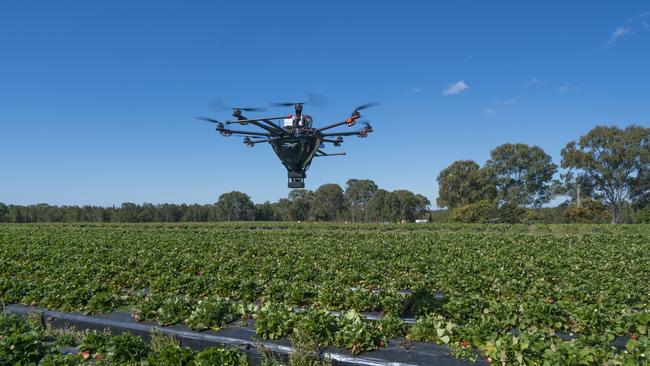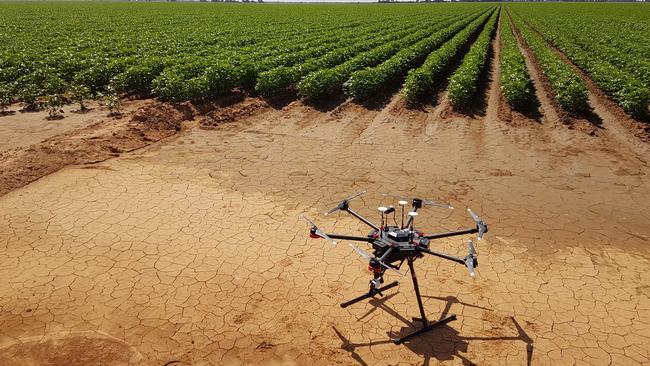Hi-tech farm jobs ready for take-off
Technology is poised to change Australian farming practice forever.

Tristan Steventon is what might be broadly termed a farm worker, but his tools of the trade aren’t a set of shears or a fencing strainer. Instead, they are vast amounts of data.
He pulls together data from satellite images, drones, yield monitors in tractors, soil sample data, images he collects from drones and other sources to help farmers make better decisions.
Steventon provides a glimpse into the sorts of employment opportunities that will become prevalent in farming in regional Australia as the sector goes hi-tech and draws more on data and automation. While the long-term trend of farmers requiring fewer farm labourers will continue, there will be an upswing in jobs requiring science, technology, engineering and mathematics training.
The founder of agricultural technology start-up StevTech, Steventon says he helps farmers run their properties more efficiently and more profitably.
“We make the really hi-tech really simple and try and deliver that in a way that either increases yields or decreases the cost of inputs,” he says.
For example, after a paddock of a wheat or barley is harvested, the ground is ploughed and left fallow for a few months to regenerate. This leaves the paddock susceptible to weeds, which take nutrients and moisture out of the soil. The solution in the past was to blanket spray the entire paddock with herbicide, but that can be an expensive proposition.
Instead, Steventon scans the paddock for weeds using a drone then uploads the data as a GPS file, identifying where the weeds are, perhaps across only 10 or 15 per cent of the paddock. The sprayer then treats the parts of the paddock with weeds and shuts off when there aren’t any.
“We’ve saved guys up to 90 per cent of their chemicals, which for some farmers, if they’re spraying almost a million bucks of chemicals a year on their places over the growing season, that can be a significant amount of money,” he says.
Steventon describes himself as a “data facilitator”, although it’s not a job that really exists at the moment.
“Where the employment is, is actually being on the ground and translating that data for the average farmer,” he says.
StevTech also deploys data for citrus growers.
A drone collects data on an orchard, telling the farmer the exact number of trees, the number of missing trees and the health, height and canopy size of each individual tree — information which farmers haven’t had until now. A couple of months before harvest, a different drone will fly over the orchard and collect data to determine how many tonnes of oranges it will produce and the amount of each size.
‘Agriculture’s still one of the least digitised sectors of the economy, but there’s so many gains to be made that we can see ahead of us in increasing its use of digital technologies’
“Two months before they start harvest they’ll know which market they need to target with what size oranges — ‘this one’s actually going to be better for the Hong Kong market or this one’s going to be better for the Australian market, or whatever’,” he says. “They’ll be able to make some good investments in terms of how they’re going to market that produce.”
The value of agriculture, fisheries and forestry production has increased by an inflation-adjusted 19 per cent in the past 20 years, from about $58bn in 1999/2000, to about $69bn in 2018/19, according to the Australian Bureau of Agricultural and Resource Economics and Sciences’ (ABARES) Snapshot of Australian Agriculture 2020.
-
-
The National Farmers’ Federation wants the industry to achieve $100bn in farmgate output by 2030. It highlights improved infrastructure in the bush, more research and development spending and better use of technology and data as key drivers.
“There are many technologies and considerable data that lie in wait ready for activation,” states an NFF-commissioned report, Agriculture — A $100b sector by 2030? “Effective use of these technologies and data will improve agriculture’s productive capacity through better farming processes and systems, and decreased labour and other input costs.”
While technology has great potential, take-up so far has been limited.
“Agriculture’s still one of the least digitised sectors of the economy, but there’s so many gains to be made that we can see ahead of us in increasing its use of digital technologies,” says Michael Robertson, deputy director of CSIRO Agriculture and Food.
One issue is that the technology is new and not always very user-friendly. Another is that farmers want to use their data and apps when they’re out in the paddock and poor internet connectivity in the bush often doesn’t allow this.
Even so, Robertson foresees great changes in agriculture. While farming might look outwardly the same — at least in the next few years — farmers will be making better decisions about management of crops and animals, marketing and risk management, and they’ll be more informed about what’s happening on the farm.

It will continue a long-established pattern in Australian agriculture of farms requiring fewer workers. But Robertson expects it will create jobs outside the farm gate.
“It may end up creating new businesses, of course off-farm, digital service companies, new forms of businesses to support agriculture that are underpinned by digital technology, so that’s the positive side,” he says.
A 2016 report by ABARES puts the agricultural workforce at 228,372, up more than 4 per cent from 2011. ABARES points out that agriculture has linkages through the supply chain and interdependence on other sectors of the economy and when employment in food and beverage manufacturing, fibre manufacturing and wholesale trade is also considered, the wider workforce connected with agriculture is estimated at 466,625.
There is continued strong demand for skilled and technical agriculture workers, which isn’t being met, says Jim Pratley, Research Professor of Agriculture, School of Agricultural and Wine Sciences at Charles Sturt University.
While there is demand for about 3000 graduates a year, universities are currently only producing about a thousand, he says.
“Those graduates are being paid in the top 10 of starting salaries after graduation, so we need to get the message through that there are really good jobs in ag. They’re hi-tech jobs, they’re finance jobs, trading jobs,” he says.
He points out that only 10 to 15 per cent of agricultural jobs are on-farm, with the others in rural services and supplies.
“We’re going to see more robotics. We’re going to see more IT-based jobs,” Pratley says.
“When we look at the sophistication of the machinery used, we’re going to need people with very good skills in being able to use that equipment.”
